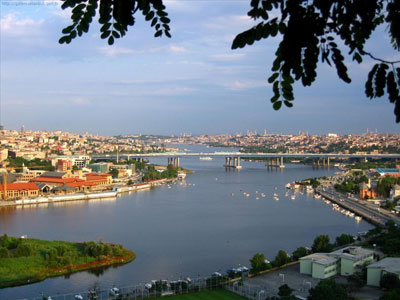
Golden Horn
The Golden Horn, a horn-shaped estuary, divides European side of Istanbul. One of the best natural harbors in the world, the Byzantine and Ottoman navies and commercial shipping interests were centered here. Today, lovely parks and promenades line the shores. In the setting sun, the water shines a golden color. There are no tides or currents here. The name Golden Horn is both a symbol of fertility because of the fertile lands on its shores, the abundance of fish in its waters, and the fresh water of the streams and a reference to its shape.
Golden Horn was an old trading point and popular shoreline residential area during the Byzantine period, it was largely inhabited by Jewish immigrants from Spain during the Ottoman period. The mixtures of Armenians, Greeks, Gypsies and Turks living along its shores reflected the city's  colorful mosaic. Since 1880 the famed Cibali cigarette factory has been operating there, which today is renovated to house a private university.
colorful mosaic. Since 1880 the famed Cibali cigarette factory has been operating there, which today is renovated to house a private university.
In the Byzantine era, a chain at the entrance prevented the entry of foreign fleets into the Golden Horn. Bridges have connected the two shores from time to time; some of them built for military purposes. At present a fifth bridge is being planned for metro trains to cross. From the piers, crowded at all times, there are regular boat tours to the Asian shore, the Bosphorus and the Princes' Islands. The Harem section of
the Topkapi Palace gives a bird's eye view of the Golden Horn. The Sepetciler Kasri on the shore was a part of the Palace complex, and it is now allocated to the use of international journalists.
During the Ottoman period, in the first half of 18th century, Golden Horn was very rich of tulip gardens and green parks where upscale people used to come to relax, and row with their boats at the romantic sunset. Nearby is the last stop of trains from Europe, the Sirkeci Railway Station built in 1890. The old Galata Bridge was recently moved to another site down the Golden Horn, and the new bridge is the largest example of its kind.
With the neglect borne of a population explosion in the 1950's and ineffective zoning laws, the once pristine Golden Horn became a churning cesspool of grey city-sewage and industrial waste. Only in the 1980's did a much needed urban clean-up begin. Polluting factories were cleared and proper sewage needs met. Now, its shores green once again, lovely parks, promenades, and playgrounds greet visitors. The water glistens golden in the sun again, perhaps not as brightly as before, but one step nearer to what the poets once described as "Sadabad", or "place of bliss".
At Fener, a neighborhood midway up the Golden Horn, whole streets of old wooden houses and churches date from Byzantine times. The Orthodox Patriarchy resides here. Eyup, a little further up, reflects the Ottoman style of vernacular architecture. Cemeteries sprinkled with dark cypress trees cover the hillsides. It is always busy here with pilgrims coming to the tomb of Eyup in the hope that their prayers will be granted. The Pierre Loti Cafe atop the hill overlooking the shrine is a wonderful place to enjoy the tranquility of the view having a traditional Turkish coffee or tea.
There was no bridge over the Golden Horn before the 19th century. Small boats provided transportation between the two shores. The first Galata Bridge, which connects present day Karaköy to Eminonü, was built in 1836, rebuilt in 1845, again in 1912, and lastly in 1993. The Unkapani (Atatürk) Bridge further up the Horn handles the flow of traffic between Beyoglu and Saraçhane. The third one over the Horn is called the Haliç Bridge.